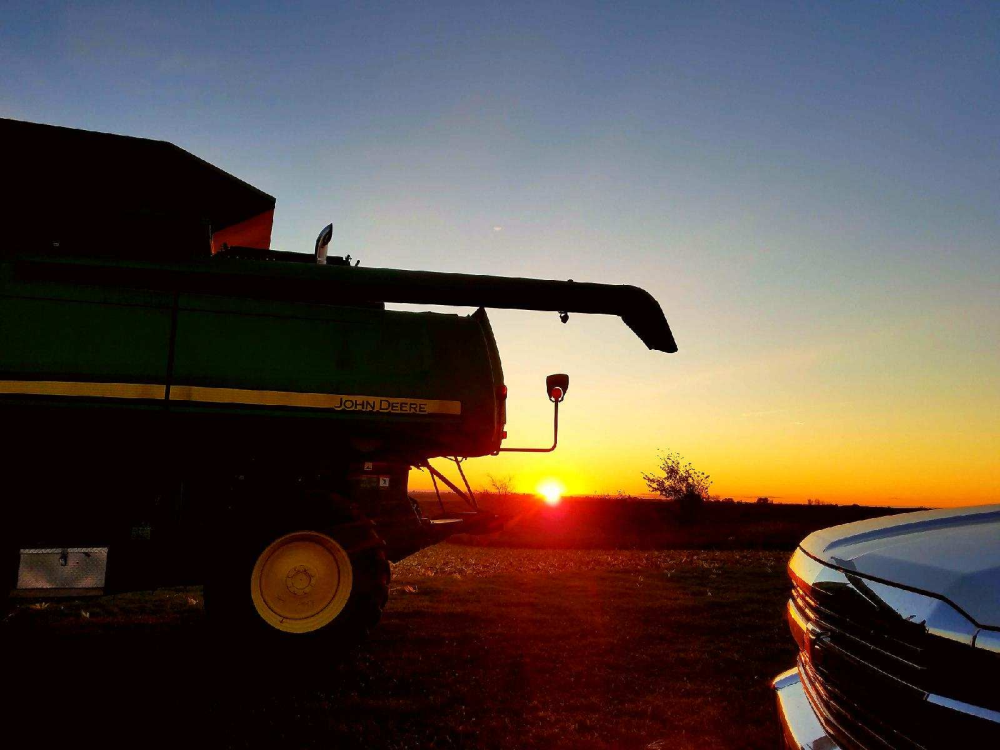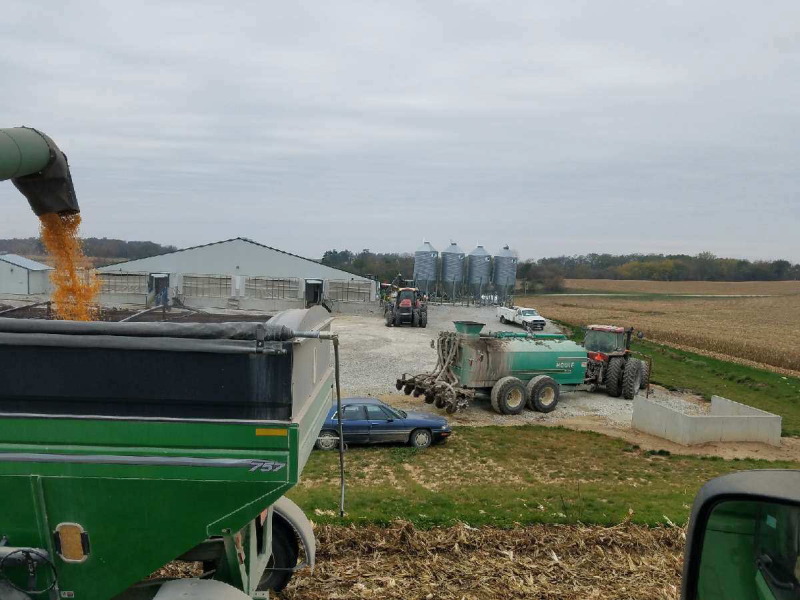Farm Life Journal - November 2017
November 17, 2017
By Mark Jackson
 November is a month of celebration; a time to honor our veterans and give thanks for the year's harvest. This is also the season in which turkey, dressing and pumpkin pie are a family tradition. Snowflakes have been seen in the crisp air and blankets of morning frost are becoming more regular. Late fall is upon us, and November brings a renewed energy for farmers after October's marathon of long work days. The farmer feels a sense of urgency this time of the year, with an eye to the sky and harvest completion in sight, we make that final dash to the finish line of the 2017 harvest year. Corn usually leads the final charge as soybeans were given harvest priority earlier in the season. Mother Nature provides corn with layers of husks to shed the weather, whereas mature soybeans have only a thin pod that will easily pop open with weather extremes.
November is a month of celebration; a time to honor our veterans and give thanks for the year's harvest. This is also the season in which turkey, dressing and pumpkin pie are a family tradition. Snowflakes have been seen in the crisp air and blankets of morning frost are becoming more regular. Late fall is upon us, and November brings a renewed energy for farmers after October's marathon of long work days. The farmer feels a sense of urgency this time of the year, with an eye to the sky and harvest completion in sight, we make that final dash to the finish line of the 2017 harvest year. Corn usually leads the final charge as soybeans were given harvest priority earlier in the season. Mother Nature provides corn with layers of husks to shed the weather, whereas mature soybeans have only a thin pod that will easily pop open with weather extremes.
Grandpa picked many a row of corn with drifts of snow, but neither man nor machine desire that thought, then or now. That last pass brings exhilaration as those final rows of crop feed into the combine and are directly offloaded onto the wagon for sale or storage. The harvest season is done - a process some 12 to 14 months ago - and brings a farmer to that moment of completion, just as the circle of farming renews itself and begins again.
Spreading the Wealth
The farmer's never-ending cycle of crop preparations continue, as soil temps have dropped, and conditions are right to apply nutrients for next spring's corn and soybeans. It's a fact of science that bountiful crops remove nutrients from the soil. A sustainable and highly efficient source of crop nutrient is the manure from my hog houses. It is analyzed annually for the content of Nitrogen, Phosphorus, Potassium (or "NPK" in farmer or gardener speak) and other micronutrients. Application rates are determined by my farm's manure management plan ("MMP" for short), a registered document monitored by the state of Iowa. The MMP is a nutrient prescription designed specifically for each individual field based on soil samples taken, crops planted and projected grain removal to determine the gallons of manure to be applied per acre.
 Excessive gallons applied become an expense, which is motivation within itself not to over-apply, not to mention it's the responsible thing to do. Putting that into perspective, my application range is 3,000 - 5,000 gallons per acre, which would be less than two-tenths of an inch of rain if spread over my fields. But I take it to the next level; all my liquid manure is injected, allowing for better odor control, soil adhesion and nutrient preservation. This process also feeds soil bacteria for healthier soils and builds soil organic matter. This nutrient package is adequate to raise an entire crop of corn and soybeans on a two-year rotation -- meaning application to a field is only every other year.
Excessive gallons applied become an expense, which is motivation within itself not to over-apply, not to mention it's the responsible thing to do. Putting that into perspective, my application range is 3,000 - 5,000 gallons per acre, which would be less than two-tenths of an inch of rain if spread over my fields. But I take it to the next level; all my liquid manure is injected, allowing for better odor control, soil adhesion and nutrient preservation. This process also feeds soil bacteria for healthier soils and builds soil organic matter. This nutrient package is adequate to raise an entire crop of corn and soybeans on a two-year rotation -- meaning application to a field is only every other year.
"The nutrient squad" is a name given to my contractor and his crew who I hire to apply all my hog manure each year. The squad arrives with a parade of tractors, tankers and pumps to orchestrate a steady flow of nutrient distribution to designated fields, metering levels right down to the gallon. Their machines have rolling cutters that part the soil surface, creating a slot for injection and immediate closure, often leaving just a mere line to know they have been there.
Cover crop seeding by grain drill continues as the combine is being parked in the machine shed. My son Michael will soon finish drilling the last few fields, and depending on Mother Nature, a few more warm, sunny days (38 degrees or more) will trigger germination of our cereal rye cover crops. The young plant will start its journey to control erosion, sequester soil nutrients and provide a magnet for fish worms and other soil biologicals. Cover crops provide a living plant with root growth for my fields during the off season before planting my primary crops of corn and soybeans next spring.
Taking a Bath
Clearing away dust, dirt and crop debris from my combine is a never-ending, season-long struggle. Fire hazards are a real threat while harvesting crops, especially during periods of dryness. Failed bearings, slipping belts and electrical shorts are just a few causes of a combine fire, which can spread quickly, destroying expensive machines and valuable standing crops. The urgency is obvious, and I've dealt with the consequences, but the frequency is minimized with the proper due diligence.
At the seasons' end, the combine is given a final "air bath," inside and out, using a four-foot-long metal wand, directing air pressure to clear all the nooks and crannies of accumulated debris. All bundled up with coat and gloves, my hood pulled tight, and with goggles and a dust mask, the process begins as a cloud of dust engulfs the combine. In the end, opportunities for rodents to build nests, chew wires and the chaos it creates is greatly reduced. The combine is now ready to be parked in the machine storage shed under the watchful eye of Grumpy…the rest is up to her.
But no rest for the weary, as the process is repeated on our detachable grain heads and then lubricated, as are the tractors, wagons and augers, all lined up under roof, protecting bearings and paint from rust and weather.
The Three Musketeers
 What started with Grumpy the shop cat, who comes and goes as she chooses, has evolved into two Bobs and Bert, the short-tailed kitten. The "Three Musketeers" (or maybe more appropriately the "2½ Musketeers") help maintain order with vermin and provide an element of entertainment around the shop. The farm's shop has become the hub of a much greater process, from which deals are made, machines are repaired, and an informal place for friends and neighbors to gather and exchange ideas.
What started with Grumpy the shop cat, who comes and goes as she chooses, has evolved into two Bobs and Bert, the short-tailed kitten. The "Three Musketeers" (or maybe more appropriately the "2½ Musketeers") help maintain order with vermin and provide an element of entertainment around the shop. The farm's shop has become the hub of a much greater process, from which deals are made, machines are repaired, and an informal place for friends and neighbors to gather and exchange ideas.
Analyze, Finalize and Write the Check
This may sound very basic and you ask what am I talking about, well, my seed purchases for next year's growing season. We were scouting corn and soybean variety plots back in July and up into September, checking a list of plant traits such as stand-ability, plant structure, insect resistance, etc. (a somewhat subjective process). But after the weigh wagon leaves the field and the final yields are tabulated, a much more objective assessment begins. Sometimes the most "handsome" plants can have the worst yields, and likewise, I've seen amazing yields come from the "homeliest" of plants. Having great yields with a plant that falls down is risky at best, making harvest difficult or affecting grain quality - all of which create a recipe for failure. One year doesn't make a winner or loser; several years across a broad range of farm fields is much more reassuring when making seed selections. And just when you find that favorite soybean variety or corn hybrid, along comes one better, all part of my sustainability efforts through continuous improvement. (I think you get the idea.)
Mother Nature is boundless and ever changing, not unlike the leaves on a tree or stars in the sky. Welcome to the world of farming, where success is based on solid science, years of experience, measured by outcomes and sprinkled with a healthy dash of luck for good measure.
So, at the end of the months-long journey, seed selections are made, and a check is finally written, but ensuring delivery of the chosen seeds is based on availability driven by supply and demand. Yes, there have been times when seed demand has outpaced supply and substitutions need to be made. There are few guarantees in farming, but perseverance and a positive attitude will prevail in the end.
Tomorrow is a new day,
Midwest agriculture at its best
Mark Jackson